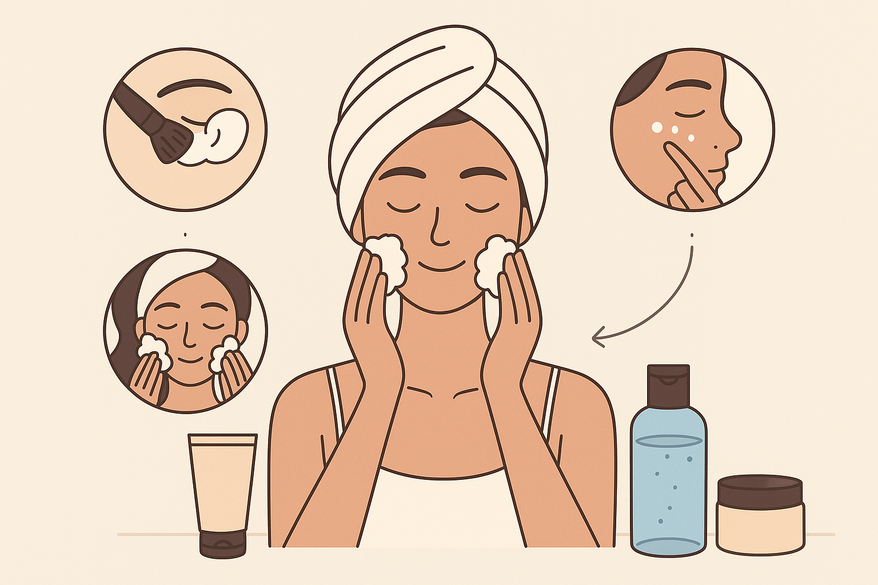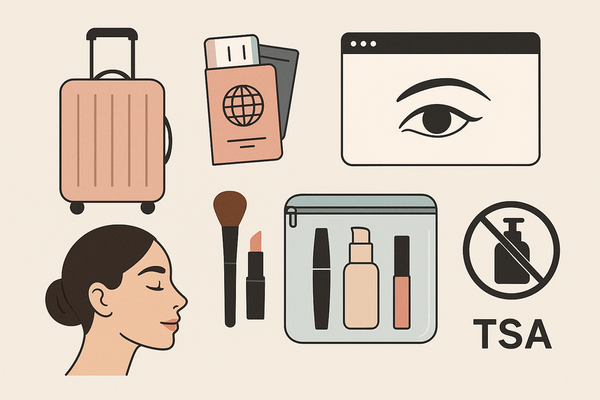The Ultimate Makeup Aftercare Routine for Healthy Skin
Learn the essential steps for a makeup aftercare routine to keep your skin healthy and your makeup lasting longer. Cleanse, tone, and moisturize correctly.

Estimated reading time: 8 minutes
Key Takeaways
- Complete removal of makeup is essential to prevent clogged pores and irritation.
- Follow the six key steps: removal, cleansing, exfoliation, toning, moisturizing, and targeted treatments.
- Double cleansing and choosing products tailored to your skin type minimize breakouts and balance hydration.
- Consistent aftercare extends makeup wear and supports glowing, healthy skin over time.
Table of Contents
- Understanding Makeup Aftercare
- Step-by-Step Effective Routine
- Tailoring the Routine to Different Skin Types
- Preventative Measures and Extra Tips
- Conclusion
- FAQ
Understanding Makeup Aftercare
- A makeup aftercare routine resets your skin by removing every trace of makeup, deeply cleansing, and restoring hydration.
- Key elements include:
- Makeup removal
- Cleansing
- Gentle exfoliation
- Toning
- Moisturizing
- Optional serums or masks
- Skipping steps can lead to clogged pores, redness, breakouts, or uneven pigment and even infections under certain conditions.
- Real-world salon experts stress that lasting makeup results depend on solid aftercare habits.
Sources:
Permanent cosmetics aftercare
MMA Makeup Academy aftercare
Fierce Aesthetics aftercare
Step-by-Step Effective Routine
Step 1: Makeup Removal
- Use a gentle, oil-based remover or micellar water to dissolve waterproof mascara and lip stains without harsh scrubbing.
- Opt for fragrance-free formulas if you have sensitive skin.
- Pro tip: Apply remover on a cotton pad, hold on closed eyes for 10 seconds, then wipe gently.
- Double-cleansing helps prevent residue build-up and keeps skin calm and clear.
For a deeper dive into removal techniques and top remover picks, check those guides.
Step 2: Cleansing
- Choose based on skin type:
- Oily: gel or foaming cleanser
- Dry: creamy or milky cleanser
- Combination: gentle foaming or balancing gel
- Double cleansing:
- First, oil-based to break down makeup and SPF.
- Second, water-based to clear away oil and dirt.
- Clients who double cleanse report fewer breakouts and smoother skin.
Step 3: Exfoliation (1–3×/week)
- Removes dead cells so pores stay clear and products absorb better.
- Choose:
- Physical scrubs (avoid if skin is sensitive)
- Chemical exfoliants (AHAs like glycolic or BHAs like salicylic)
- Use 1–3 times weekly; avoid on the same day as heavy treatments to prevent barrier damage.
Step 4: Toning
- Restores pH balance and preps skin for hydration.
- Pick alcohol-free options with botanicals like rose water or aloe vera.
- Apply with a cotton pad or by pressing gently with your palms.
Step 5: Moisturizing
- Seal in hydration:
- Gel formulas for oily skin
- Creams for dry skin
- Light lotions for combination skin
- Look for non-comedogenic labels to avoid clogged pores.
Step 6: Additional Treatments
- Serums:
- Hyaluronic acid for hydration
- Niacinamide for redness
- Vitamin C for antioxidant protection
- Eye cream: a small dot under each eye to combat fine lines.
- Spot treatments: benzoyl peroxide or salicylic acid on blemishes.
Product favorites include Cetaphil Gentle Skin Cleanser, CeraVe Hydrating Cleanser, Bioderma Sensibio H2O, Clinique Take The Day Off Balm, Paula’s Choice 2% BHA Liquid Exfoliant, Neutrogena Hydro Boost Gel Cream, and First Aid Beauty Ultra Repair Cream.
Tailoring the Routine to Different Skin Types
- Oily skin: Emphasize gel cleansers and oil-control toners. Exfoliate with BHAs.
- Dry skin: Use milky cleansers, rich creams, and hydrating serums like hyaluronic acid.
- Combination skin: Balance with gentle gels and lightweight lotions; treat oilier zones with targeted products.
- Sensitive skin: Skip harsh scrubs, choose fragrance-free, soothing botanicals, and test new products on a patch.
Preventative Measures and Extra Tips
- Always patch-test new items to avoid reactions.
- Sanitize brushes and sponges regularly to cut down on bacteria.
- Refresh mid-day with a hydrating mist if makeup feels dry.
- Stay hydrated and maintain a balanced diet for skin support from within.
Conclusion
A consistent makeup aftercare routine ensures clear pores, balanced hydration, and extended wear. Follow each step—removal, cleansing, exfoliation, toning, moisturizing, and targeted treatments—to give your skin the TLC it deserves. Commit to this ritual daily and nightly for radiant, healthy skin and flawless, long-lasting makeup.
Share your go-to aftercare tips below. Want more? Check out our essential post-makeup skincare tips.
FAQ
How long does a full aftercare routine take?
On average, expect 10–15 minutes from start to finish. Double cleansing and exfoliation add a bit more time but are well worth the results.
Can I skip exfoliation if my skin is sensitive?
Yes—reduce frequency to once a week or switch to a gentle chemical exfoliant (like lactic acid) and always patch-test.
How often should I perform this routine?
Every evening after wearing makeup. For daytime, simply cleanse and apply SPF before makeup.
Are these product recommendations suitable for all skin types?
Most are non-comedogenic and gentle, but always select formulations based on your individual skin needs and sensitivities.




